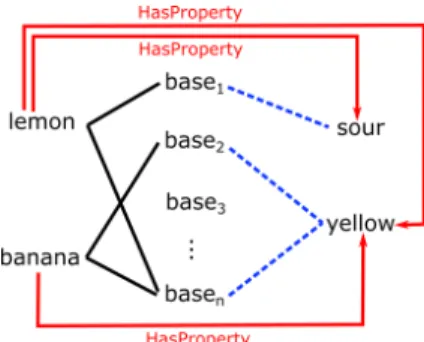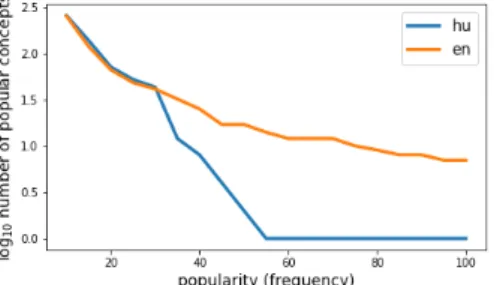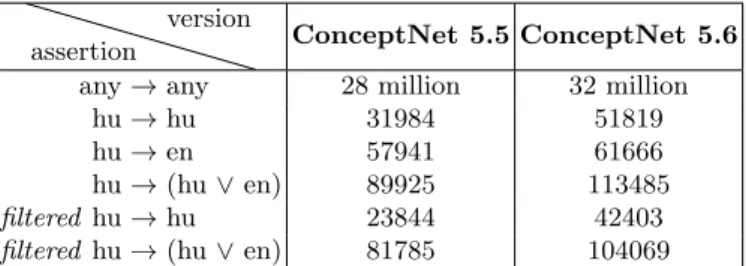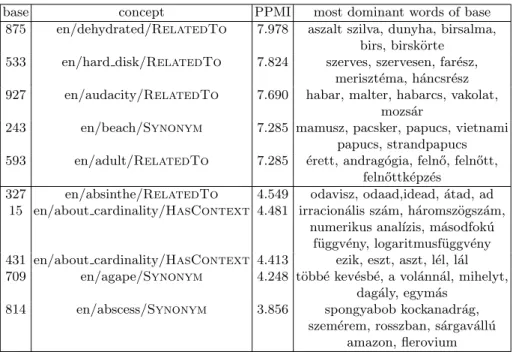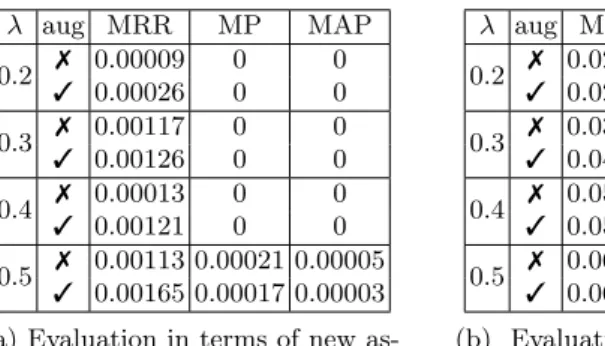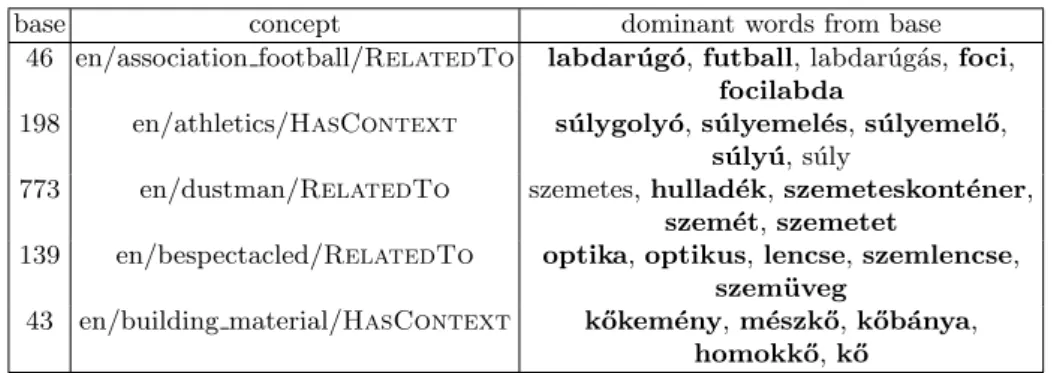Interpretability of Hungarian embedding spaces using a knowledge base
Vanda Balogh1, G´abor Berend1,2, Dimitrios I. Diochnos3, Gy¨orgy Tur´an2,4, Rich´ard Farkas1
1Szegedi Tudom´anyegyetem, Informatikai Int´ezet
2MTA-SZTE Mesters´eges Intelligencia Kutat´ocsoport
3Department of Computer Science, University of Virginia
4Department of Mathematics, Statistics, and Computer Science, University of Illinois at Chicago
{bvanda, berendg, rfarkas}@inf.u-szeged.hu diochnos@virginia.edu gyt@uic.edu
Abstract. While word embeddings have proven to be highly useful in many NLP tasks, they are difficult to interpret for humans. Sparse word embeddings are reminiscent of knowledge bases containing words that are already characterized in sparse forms. In our work, we investigate to what extent sparse word representations convey knowledge about the words in knowledge bases. We utilize Hungarian sparse word embeddings and ConceptNet, a knowledge base that supports Hungarian.
Keywords: sparse word embedding, interpretability, knowledge base, ConceptNet
1 Introduction
Word embeddings generate low dimensional word representations from large cor- pora. Each word is represented as a vector of real numbers. Word vectors that are similar to each other tend to be semantically related which makes word em- beddings effective in a variety of natural language processing tasks. Even though word embeddings perform well in these tasks, they are difficult to interpret for humans. Word embeddings employ dense representations of words, while natu- ral language phenomena are extremely sparse by their nature. Motivated by this sparse behaviour, the construction of word embeddings that were made sparse is getting popular recently [1,2,3,4,5].
Knowledge bases already include words in sparse forms implicitly. The rela- tions in these knowledge bases can describe how the words are related to each other by their lexical definition, and also how they are related through com- monsense knowledge. Thus, we have human interpretable features at hand. This appealing characteristic of human assembled knowledge representation has al- ready inspired others to create non-distributional word representations [6].
In our work, we would like to explore the interpretability of the dimensions of distributed word embeddings. As our first experiment, we examine Hungarian sparse embedding matrices by assigning each dimension one concept extracted
from ConceptNet[7], a multilingual knowledge base. One potential application of these assignments can be knowledge graph expanding.
2 Related Work
The explanatory power of distributional semantic models (DSMs) in terms of meaning is not clear as they often provide a quite coarse representation of se- mantic content [8]. There have been proposals for the semantic evaluation of DSMs, e.g.,qvec[9] andbless[10]. Theqvecevaluation measure aims to score the interpretability of word embeddings, a topic close to our research. Dimen- sions of the word embeddings are aligned with interpretable dimensions – cor- responding to linguistic properties extracted from SemCor [11] – to maximize the cumulative correlation of the alignment.Blessis a dataset designed for the semantic evaluation of DSMs. It contains semantic relations connecting (target and relatum) concepts as tuples. Thus,blessallows the evaluation of models by their ability to extract related words given a target concept. The method called the Thing Recognizer [12] attempts to make Hungarian embedding spaces interpretable by assigning semantic features to words in a language-independent manner.
In the following, we briefly introduce ConceptNet, a semantic multilingual knowledge base. In our work, we extract interpetable features (concepts) from ConceptNet in order to help exploring the interpretability of the dimensions of word embeddings.
2.1 ConceptNet
Relation Symmetric Example Assertion Antonym 3 deep↔shallow HasContext 7 gurl→slang
HasProperty 7 marsh→muddy and moist
IsA 7 eagle→bird
MadeOF 7 ice→water Synonym 3 bright↔sunny RelatedTo 3 torture↔pain
UsedFor 7 science→understand life Table 1: Extract of relations from ConceptNet 5.
ConceptNet is a semantic multilingual knowledge base describing general human knowledge collected from a variety of resources including WordNet, Wik- tionary and Open Mind Common Sense. ConceptNet can be perceived as a graph whose nodes correspond to words and phrases. The nodes of the semantic net- work are calledconcepts and the (directed) edges connecting pairs of nodes are called relations. The records of the knowledge base are called assertions. Each assertion associates two concepts –start andend nodes – with a relation in the
semantic network and has additional satellite information beyond these three objects; for example, thedataset from where the assertion was obtained (e.g., WordNet). Figure 1 provides an example of an assertion found in ConceptNet 5 – the latest iteration of ConceptNet. Relations can be symmetrical, e.g., Syn- onym and RelatedTo, or asymmetrical, e.g., HasProperty and IsA. An incomplete list of relations present in ConceptNet 5 can be found in Table 1.
{
” d a t a s e t ” : ”/ d/ w i k i t i o n a r y / en ” ,
” l i c e n s e ” : ” c c : by−s a / 4 . 0 ” ,
” s o u r c e s ” : [{” c o n t r i b u t o r ” : ”/ s / r e s o u r c e / w i k i t i o n a r y / en ”}] ,
” w e i g h t ” : 1 . 0 ,
” u r i ” : ”/ a / [ / r / HasContext / , / c /hu/ p o l i g o n /n / , / c / en / geometry / ] ” ,
” r e l ” : ”/ r / HasContext ” ,
” s t a r t ” : ”/ c /hu/ p o l i g o n /n ” ,
” end ” : ”/ c / en / geometry ” }
Fig. 1: Example assertion from ConceptNet 5. Thestart andend nodes are con- nected by an edge labelledrel corresponding to the relation between the nodes.
Assertions feature additional information likedatasetwhich represents the source of the assertion andweight, the strength of the assertion which is a positive value.
3 Experiments
Our aim is to explore the interpretability of the dimensions of Hungarian em- bedding matrices by assigning each dimension a human interpretable feature. A somewhat unnatural characteristic of standardly applied word embeddings (e.g.
word2vec [13] or Glove [14]) is that the learned vectors have non-zero coefficients everywhere, implying that every word can be characterized with every dimen- sion at least to a tiny extent. From a human perception point of view this dense behavior is quite undesired, because for most features we would not like to see any relation to hold. To approximate the sparse behaviour of natural language phenomena, we employ embeddings that are turned sparse as a post-processing step suggested in [4]. Results from other studies and literature argue that sparse word representations are more interpretable by humans (e.g. word intrusion) and perform well on downstream tasks (e.g. sentiment analysis) [1,3,2,5,15,4].
The rows of a sparse embedding matrixS, correspond to sparse word vectors representing words. We call the columns (dimensions) of the sparse embedding matrixbases. As human interpretable features, we take concepts extracted from a semantic knowledge base, ConceptNet, and the sparse embedding we employ is derived from the dense Numberbatch [16] vectors. This way, our goal reformulates to designating a concept to each base.
We basically deal with a tripartite graph (see Figure 2) with words connected to bases – corresponding to the columns of the embedding matrix – and concepts,
Fig. 2: Tripartite graph presenting the connections between embedded words, bases and concepts. Connections denoted by solid lines are present, our aim is to recover the relations between bases and concepts (dashed lines).
respectively. A word,wis connected tobasei if theith coordinate of the sparse word vector corresponding to w is nonzero. Also, w is connected to a concept c with label l if there exists an assertion in ConceptNet that associates w and c with the relation l. We are interested in the relations between concepts and bases (dotted lines).
3.1 Hungarian sparse word embeddings
Numberbatch [16] is an embedding approach combining distributional semantics and ConceptNet 5.5 using a variation on retrofitting [17]. The Hungarian sparse word embeddings are derived from dense Numberbatch embeddings related to Hungarian concepts (i.e., concepts prefixed with /c/hu/). As a side note, the words present in ConceptNet align much better with the vocabulary provided by Numberbatch than with other embeddings’ vocabulary. This is because Number- batch implicitly makes use of words (and their specific forms) from ConceptNet and any arbitrary embedding would include a vast amount of forms of a single word since Hungarian is a morphologically rich language.
Sparse embeddingssiare derived from dense embeddingsxiaccording to the objective function
D∈C,smin 1 2n
n
X
i=1
kxi−Dsik22+λksik1
,
whereDis a dictionary matrix of basis vectors with length not exceeding 1. The regularization constant,λ controls the sparsity of the resulting embeddingssi. As λincreases, the density of the nonzero coefficients in si decreases. In total, we use four sparsity levels according toλs from{0.2,0.3,0.4,0.5}. Table 2 shows sparsity of each sparse embedding matrix. We have a vocabulary of 17k words which are embedded into a vector space of 1000 dimensions.
λ 0.2 0.3 0.4 0.5 sparsity 99.66% 99.81% 99.88% 99.92%
Table 2: The ratio of zero elements to all the elements from sparse embedding matrices withλregularization coefficient.
3.2 Hungarian ConceptNet
We utilize the Hungarian part of ConceptNet 5.5 and ConceptNet 5.6. in our experiments. Every assertion has astart andend node, which are connected by a directed labeled edge where the label is specified by the relation between the nodes. Basically, an assertion is a triplet of (start node, relation, end node). If the relation is symmetric, the connecting edge is bidirectional. In the following, we refer to start nodes as (embedded) words and end nodes are regarded as concepts (which should not be confused with the concepts mentioned in Section 2.1). These end nodes – seen as concepts – will be assigned to the bases of the sparse embedding matrix.
Fig. 3: Comparison on the number of English and Hungarian concepts that ap- pear frequently (above frequency) as end nodes in assertions. The y axis shows the log10of the number of concepts that are frequent.
For our experiments, we produce the subgraph of ConceptNet which encodes useful information on Hungarian (embedded) words. It is important to note that English is a core language of ConceptNet (i.e. the language is admittedly well supported) while Hungarian is not. First, we take the assertions associating two Hungarian nodes and to further diversify them, we adopt assertions associating a Hungarian start node with an English end node. It is worth to expand the set of concepts with English concepts, because there are significantly more English concepts that appear a lot as end nodes of assertions i.e. among the popular concepts there are more English ones (see Figure 3). To avoid redundancy, the assertions including symmetric relations that connect two Hungarian concepts are dropped. Instead, these groups of Hungarian words defined by symmetric relations (eg. synsets via the Synonym relation) are represented by English end nodes. In other words, the assertions including symmetric relations between Hungarian and English are kept in order to group together Hungarian concepts connected by symmetric relations according to their English equivalent. As an
example the Hungarian synonyms ”ronda”, ”cs´unya” and ”ocsm´any” are all connected to the English ”ugly” through aSynonymrelation. Instead of working with the complete graph of these Hungarian words that contains unnecessary information, we simply make use of the information that they can be grouped together by the English ”ugly”.
assertion
version
ConceptNet 5.5 ConceptNet 5.6
any→any 28 million 32 million
hu→hu 31984 51819
hu→en 57941 61666
hu→(hu∨en) 89925 113485
filtered hu→hu 23844 42403
filtered hu→(hu∨en) 81785 104069
Table 3: Summary on the number of assertions in ConceptNet 5.5 and Con- ceptNet 5.6. The assertion types are listed according to the languages of the connected nodes. The filtered assertions disregard possible assertions associat- ing two Hungarian nodes with a symmetric relation.
Altogether, we have a result of 81k and 104k assertions from ConceptNet 5.5 and 5.6, respectively. Further on, we will refer to the resulting subsets of ConceptNet globally asHungarian Conceptnet (HCN) and use it in our exper- iments. The version 5.5 or 5.6 (of HCN) is always specified if required. Table 3 summarizes the number of assertions present in HCN 5.5 and 5.6. For further purposes, we experiment with end nodes that are with the connecting relation to reflect the meaning of assertions. We call this approachaugmented in terms of the representation of end nodes – seen as concepts. So the assertion associating
”eb” and ”dog” with theSynonym relation has its start node ”eb” and its end node is ”dog/Synonym”.
Basically, HCN 5.5 is used for association of concepts to bases and HCN 5.6 is used for evaluation. All in all, there are 48k and 58k distinct end nodes included in HCN 5.5 and HCN 5.6., respectively. If we ignore the relations by which end nodes were augmented we get 44k and 53k different relations. Although relations may be important in terms of meaning, we may resort to ignoring them to be able to further group together words according to their connecting concepts.
Ignoring relations is also motivated by assertions like (a fi´ok,Synonym, jacket), which presents a case where probably the relationSynonym is wrong between the word ”a fi´ok” and ”jacket”. A relation like AtLocation or RelatedTo would fit better. In general, we use two types representation for concepts (ends nodes): the ones ignoring relations and the augmented approach.
Overall, there are 26 types of relations present in HCN. Surprisingly, there are relations for which there are substantially fewer assertions in HCN 5.6 than HCN 5.5 (see Figure 4). A lot of relations have the same number of assertions in both versions of HCN. The relationEtymologicallyDerivedFromis not present in HCN 5.5 and some of the richest relations include DerivedFrom, FormOf, RelatedToandSynonym.
Fig. 4: Log10 frequency of the assertions in HCN 5.5 and 5.6 according to rela- tions. The relation EDF is short forEtymologicallyDerivedFromand ERT refers toEtymologicallyRefersTo.
3.3 Phases of association
The process of associating a base with a concept is divided into four phases.
First, we produce an adjacency matrix based on HCN 5.5, then we multiply its transpose with the sparse word embedding matrix. Afterwards, the positive pointwise mutual information (PPMI) values of the resulting matrix are com- puted and finally, the association takes place by taking the argmax of the matrix containing PPMI values. The four phases are detailed below. Figure 5 provides an overview of the four phases.
I. Produce ConceptNet matrix. Given HCN 5.5 (described in §3.2), we consider it as a bipartite graph whose two sets of vertices correspond to two ordered sets containing the start and end nodes of assertions, respectively. The start nodes are regarded as (possibly embedded) words and the end nodes as concepts. The bipartite graph is represented as a biadjacency matrixC (which simply discards the redundant parts of a bipartite graph’s adjacency matrix).
Every word w corresponding to a start node is associated with an indicator vectorvw where theith coordinate ofvw is 1 ifw is associated to the ith end node, 0 otherwise. At this point, words can have two sparse representations: the vectors coming from sparse word embeddings and the binary vectors provided by HCN. To differentiate them, we call the former onesembedded vectors and the latter ones ConceptNet vectors. It is important to note, that it is possible for an embedded word to lack its ConceptNet vector representation if the word itself is not present in the set of start nodes. On another note, there are words
in HCN 5.5 that are not presented in the vocabulary of the embedding; that is, they do not have embedded vector representations.
II. Compute product. We binarize the nonnegative sparse embedding matrix S by thresholding it at 0, then we take the product of the transpose of C and the binarized version ofS. The result is a dense matrixA, whose element at the ith row andjth column equals the number of words theith concept and thejth base (from the sparse embedding matrix) appear together.
III. Compute PPMI. To generate a sparse matrix from the denseAmatrix, we compute its positive pointwise mutual information (PPMI) for every element.
PPMI for theith conceptci andjth base bj is computed as PPMI(ci, bj) = max
0,ln P(ci, bj) P(ci)P(bj)
,
where probabilities are approximated as relative frequencies of words as follows:
P(ci) is the relative frequency of words connected to the ith concept, P(bj) takes the relative frequency of words whose jth coefficient in their embedded vector representation is nonzero and P(ci, bj) is the relative frequency of the co-occurrences of the words mentioned above. The result is a sparse matrixP whose columns correspond to bases, and its rows correspond to concepts.
IV. Take argmax. By taking the arguments of the maximum vales of every column inP we can associate a base with a concept.
Association( s p a r s e w o r d e m b e d d i n g , c o n c e p t n e t ){ n o d e s = {( s t a r t , end ) i n c o n c e p t n e t} C = biadjacency( n o d e s )
A = transpose(C) ∗ binarize( s p a r s e w o r d e m b e d d i n g ) P = PPMI(A)
m a x c o n c e p t s = argmax(P , max by=columns ) //the ith element is the concept associated with the ith base return m a x c o n c e p t s
}
Fig. 5: The process of associating concepts to bases summarized in pseudocode.
4 Evaluation metrics
To evaluate the associations between bases and concepts, we employ HCN 5.6.
We are interested if the new assertions compared to HCN 5.5 are presented in the associations (which can be perceived as a link prediction task). We would like to measure if the prominent words of the ith base (i.e., the words whose ith embedded coordinate is nonzero) are in relation with the concept associated
to theith base according to HCN 5.6 (only new assertions are considered). We define the setDbi as the set that contains the prominent words of basebi, i.e.
Dbi ={wj|wj(i)>0,1≤j≤n}
where wj(i) is theith coordinate in the embedded vector representation ofwj
andnis the size of the vocabulary of the sparse embedding. It is worth to mention that Dbi only depends on the embedding itself. Furthermore, we define Fbi as the subset ofDbi that contains words which are present in the new assertions as start nodes and have a connecting end node to the concept that is associated to bi, formally
Fbi={wj|wj ∈Dbi and (wj, concept(bj))∈N},
whereconcept(bj) is the concept associated tobiandNcontains(start node, end node) pairs that make a new assertion to HCN 5.6. The following information retrieval measures are used for evaluation:
Mean Reciprocal Rank The reciprocal rank (RR) of theith base,bi is RR(bi) = 1
rank(wFbi),
where wFbi is the word from Fbi with the highest coefficient in bi, and for a word,w, rank(w) is the rank ofwamongDbi, so that the word with the largest coefficient inDbihas a rank of 1, and the word with the smallest coefficient has a rank of|Dbi|. Mean Reciprocal Rank (MRR) is the mean of the reciprocal ranks over all the bases.
Mean Precision The precision of basebi is computed as Prec(bi) = |Fbi|
|Dbi|. This way, mean precision (MR) equals m1 Pm
i=1Prec(bi), wheremis the number of bases.
Mean Average Precision The average precision of basebi is the following:
AvgPrec(bi) = 1
|Dbi|
n
X
k=1
|Fbk
i|
|Dbk
i|, where bothFbk
iandDkb
iare cutoffs ofFbi andDbi, respectively, so that the words are restricted to the first k words coming from the embedding vocabulary (of sizen). Mean average precision is the mean of average precisions over the bases.
In addition to all the above, we examine these metrics in the light of all the assertions in HCN 5.5 and 5.6. In this case we only have to alter the definition of the setFbi to
Fˆbi={wj|wj ∈Dbi and (wj, concept(bj))∈Nˆ},
where ˆN contains(start node, end node)pairs that make an assertion in HCN 5.5 or 5.6, i.e., we let the assertions of both HCN versions to overlap.
5 Results and Discussion
Based on PPMI values, we map a concept to each base. Some associations can be inspected in Table 4. The first thing we notice is that English concepts are much more frequent than Hungarian ones. The proportion of English concepts is ranging between 98.9% and 100% for allλs. One reason behind this is definitely that within HCN 5.5 the number of different English concepts is 35k (38k aug- mented), while the number of Hungarian concepts is 9k (9k augmented). Also, English concepts are more popular (see Figure 3).
Some concepts associated with bases reflect the dominant words of the bases (the words that had the highest coefficient in the specific base). However, some concepts seem to have nothing in common with the dominant words of the asso- ciated base. This might be because some of the less dominant words of the base contribute to the PPMI. For example, the concept ”en/accident/Synonym” is associated with the 10th base of the sparse embedding matrix (λ=0.2) whose most dominant words include ”szem´elyg´epkocsi”, ”automobil”, ”aut´os”, ”kocsi”,
”aut´o”, however, there are words – like ”baleset”, ”ment˝oaut´o”, ”g´azol”, ”¨utk¨oz´es”,
”gyorshajt´as”, ”ittas vezet´es” – with smaller coefficients in the base that have more in common with the concept itself.
base concept PPMI most dominant words of base
875 en/dehydrated/RelatedTo 7.978 aszalt szilva, dunyha, birsalma, birs, birsk¨orte
533 en/hard disk/RelatedTo 7.824 szerves, szervesen, far´esz, meriszt´ema, h´ancsr´esz 927 en/audacity/RelatedTo 7.690 habar, malter, habarcs, vakolat,
mozs´ar
243 en/beach/Synonym 7.285 mamusz, pacsker, papucs, vietnami papucs, strandpapucs 593 en/adult/RelatedTo 7.285 ´erett, andrag´ogia, feln˝o, feln˝ott,
feln˝ottk´epz´es
327 en/absinthe/RelatedTo 4.549 odavisz, odaad,idead, ´atad, ad 15 en/about cardinality/HasContext 4.481 irracion´alis sz´am, h´aromsz¨ogsz´am,
numerikus anal´ızis, m´asodfok´u f¨uggv´eny, logaritmusf¨uggv´eny 431 en/about cardinality/HasContext 4.413 ezik, eszt, aszt, l´el, l´al 709 en/agape/Synonym 4.248 t¨obb´e kev´esb´e, a vol´ann´al, mihelyt,
dag´aly, egym´as 814 en/abscess/Synonym 3.856 spongyabob kockanadr´ag,
szem´erem, rosszban, s´argav´all´u amazon, flerovium
Table 4: Association pairs scoring the highest and lowest PPMI values at sparse embedding withλ= 0.2 using concepts augmented with relation type.
The associations are evaluated on four sparse word embeddings (based on their regularization constants) with two types of concept sets (with or without relations). Three evaluation measures connected to information retrieval (MRR,
MP, MAP) are used which can focus on either the new assertions to HCN 5.6 or all the assertions present in HCN 5.5 and 5.6. Table 5 shows the evaluation scores. The results of new assertions to HCN 5.6 naturally have very low scores.
This is because, out of the 48k concepts in HCN 5.5, at most 1k is used for the associations and most of the concepts (end nodes) present in the new assertions come from the remaining 47k concepts. On average, there is only 35 common concepts between the concepts coming from the associations and the new asser- tions to HCN 5.6. Also, we know that there are around 20k more assertions in HCN 5.6, however this version of HCN introduces 5k assertions with concepts (end nodes) not present in HCN 5.5.
λ aug MRR MP MAP
0.2 7 0.00009 0 0
3 0.00026 0 0
0.3 7 0.00117 0 0
3 0.00126 0 0
0.4 7 0.00013 0 0
3 0.00121 0 0
0.5 7 0.00113 0.00021 0.00005 3 0.00165 0.00017 0.00003 (a) Evaluation in terms of new as- sertions to HCN 5.6.
λ aug MRR MP MAP
0.2 7 0.02093 0.00333 0.00487 3 0.02197 0.00334 0.00485 0.3 7 0.03780 0.00812 0.01178 3 0.04086 0.00829 0.01228 0.4 7 0.05440 0.01559 0.01858 3 0.05661 0.01553 0.01963 0.5 7 0.06731 0.02797 0.03090 3 0.06917 0.02573 0.02960 (b) Evaluation on all assertions available to HCN 5.5 and 5.6
Table 5: Evaluation scores for associations using sparse embeddings withλreg- ularization constant, and concepts from HCN 5.5 either including relations or ignoring them.
We can observe that sparser embeddings (with higher λ values) perform significantly better in terms of all evaluation metrics. Moreover, embeddings with lowerλvalues miss most of the new assertions to HCN 5.6, which results in near zero scores. A reason for that can be that ”less sparse” embeddings contain too much noise. Ignoring relations of concepts definitely helps the new assertions in terms of MP and MAP, although this is not true for all the assertions, generally.
However, the MRR values are consistently better at augmented representations of concepts: on average the 16th most dominant word of each base (of the sparse embedding withλ= 0.5) is connected to the associated concept in either HCN5.5 or 5.6. The augmented representation of concepts restricts associations, but gives more precise results.
Some highlights from the best performing associations can be seen in Table 6.
We can notice that some of the dominant words of specific bases do not actually form assertions in HCN together with the associated concepts. Thus, the power of the resulting associations resides in the ability to augment existing knowledge bases or improve their quality.
base concept dominant words from base 46 en/association football/RelatedTo labdar´ug´o,futball, labdar´ug´as,foci,
focilabda
198 en/athletics/HasContext s´ulygoly´o,s´ulyemel´es,s´ulyemel˝o, s´uly´u, s´uly
773 en/dustman/RelatedTo szemetes,hullad´ek,szemeteskont´ener, szem´et,szemetet
139 en/bespectacled/RelatedTo optika,optikus,lencse,szemlencse, szem¨uveg
43 en/building material/HasContext k˝okem´eny,m´eszk˝o,k˝ob´anya, homokk˝o,k˝o
Table 6: Example for remarkable associations between concepts and bases with some of the dominant words in the base. Words inbolddo not form an assertion in HCN with the associated concept, making the resulting associations applicable in knowledge base expanding.
6 Conclusion
The general theme of our study was the interpretability of Hungarian word embeddings. We experimented with associating a property (concept) for each column of the embedding matrix. Motivated by the sparse behaviour language phenomena, we employed sparse word embeddings which provide sparse vectorial representation for words.
We utilized four Hungarian sparse embeddings provided by Numberbatch.
The concepts were extracted from ConceptNet 5 with Hungarian language in focus. English concepts were adopted to enrich the set of concepts and because they were more popular among assertions. The concepts could either be aug- mented with relations or not. The strategy of association was based on PPMI values. To measure how the associations reflect the assertions, we introduced four metrics, namely Mean Reciprocal Rank, Mean Average Reciprocal Rank, Mean Precision and Mean Average Precision.
Overall, the results confirm the results of [10,9] that word embeddings have semantic content related to word meaning, and provide a further step towards identifying such word meanings explicitly. We can conclude that sparser rep- resentations (with higher λ) perform better in terms of all evaluation metrics, probably because they contain less noise. The augmented approach of concept representations seems to have more precise results in terms of ranking, but it is subject to noise. On the other hand, the non-augmented approach may be more comprehensive. Also, the results indicate that associations may provide help in expanding knowledge bases, especially ConceptNet. In our ongoing work we explore more general forms of word meaning.
Acknowledgments
This work was supported by the National Research, Development and Innova- tion Office of Hungary through the Artificial Intelligence National Excellence Program (grant no.: 2018-1.2.1-NKP-2018-00008).
References
1. Subramanian, A., Pruthi, D., Jhamtani, H., Berg-Kirkpatrick, T., Hovy, E.H.:
SPINE: sparse interpretable neural embeddings. In: Proceedings of the Thirty- Second AAAI Conference on Artificial Intelligence, (AAAI-18), the 30th innovative Applications of Artificial Intelligence (IAAI-18), and the 8th AAAI Symposium on Educational Advances in Artificial Intelligence (EAAI-18), New Orleans, Louisiana, USA, February 2-7, 2018. (2018) 4921–4928
2. Murphy, B., Talukdar, P.P., Mitchell, T.M.: Learning effective and interpretable semantic models using non-negative sparse embedding. In Kay, M., Boitet, C., eds.: COLING 2012, 24th International Conference on Computational Linguistics, Proceedings of the Conference: Technical Papers, 8-15 December 2012, Mumbai, India, Indian Institute of Technology Bombay (2012) 1933–1950
3. Faruqui, M., Tsvetkov, Y., Yogatama, D., Dyer, C., Smith, N.A.: Sparse overcom- plete word vector representations. In: Proceedings of the 53rd Annual Meeting of the Association for Computational Linguistics and the 7th International Joint Conference on Natural Language Processing (Volume 1: Long Papers), Association for Computational Linguistics (2015) 1491–1500
4. Berend, G.: Sparse coding of neural word embeddings for multilingual sequence labeling. Transactions of the Association for Computational Linguistics5(2017) 247–261
5. Sun, F., Guo, J., Lan, Y., Xu, J., Cheng, X.: Sparse word embeddings using l1 regularized online learning. In: IJCAI, IJCAI/AAAI Press (2016) 2915–2921 6. Faruqui, M., Dyer, C.: Non-distributional word vector representations. In: Proceed-
ings of the 53rd Annual Meeting of the Association for Computational Linguistics and the 7th International Joint Conference on Natural Language Processing (Vol- ume 2: Short Papers), Association for Computational Linguistics (2015) 464–469 7. Speer, R., Havasi, C.: Representing general relational knowledge in conceptnet
5. In: Proceedings of the Eighth International Conference on Language Resources and Evaluation (LREC-2012), European Language Resources Association (ELRA) (2012)
8. Lenci, A.: Distributional models of word meaning. Annual Review of Linguistics 4(1) (2018) 151–171
9. Tsvetkov, Y., Faruqui, M., Ling, W., Lample, G., Dyer, C.: Evaluation of word vector representations by subspace alignment. In: EMNLP, The Association for Computational Linguistics (2015) 2049–2054
10. Baroni, M., Lenci, A.: How we BLESSed distributional semantic evaluation. In:
Proceedings of the GEMS 2011 Workshop on GEometrical Models of Natural Lan- guage Semantics. GEMS ’11, Stroudsburg, PA, USA, Association for Computa- tional Linguistics (2011) 1–10
11. Miller, G.A., Leacock, C., Tengi, R., Bunker, R.: A semantic concordance. In:
HLT, Morgan Kaufmann (1993)
12. Nov´ak, A., Nov´ak, B.: Cross-lingual generation and evaluation of a wide-coverage lexical semantic resource. In: Proceedings of the Eleventh International Confer- ence on Language Resources and Evaluation (LREC-2018), European Language Resource Association (2018) 45–51
13. Mikolov, T., Chen, K., Corrado, G., Dean, J.: Efficient estimation of word repre- sentations in vector space. CoRRabs/1301.3781(2013)
14. Pennington, J., Socher, R., Manning, C.: Glove: Global vectors for word represen- tation. In: Proceedings of the 2014 Conference on Empirical Methods in Natural Language Processing (EMNLP), Doha, Qatar, Association for Computational Lin- guistics (2014) 1532–1543
15. Vyas, Y., Carpuat, M.: Sparse bilingual word representations for cross-lingual lexical entailment. In: Proceedings of the 2016 Conference of the North American Chapter of the Association for Computational Linguistics: Human Language Tech- nologies, San Diego, California, Association for Computational Linguistics (2016) 1187–1197
16. Speer, R., Chin, J., Havasi, C.: Conceptnet 5.5: An open multilingual graph of general knowledge (2017)
17. Faruqui, M., Dodge, J., Jauhar, S.K., Dyer, C., Hovy, E., Smith, N.A.: Retrofitting word vectors to semantic lexicons. In: Proceedings of the 2015 Conference of the North American Chapter of the Association for Computational Linguistics: Human Language Technologies, Association for Computational Linguistics (2015) 1606–
1615
